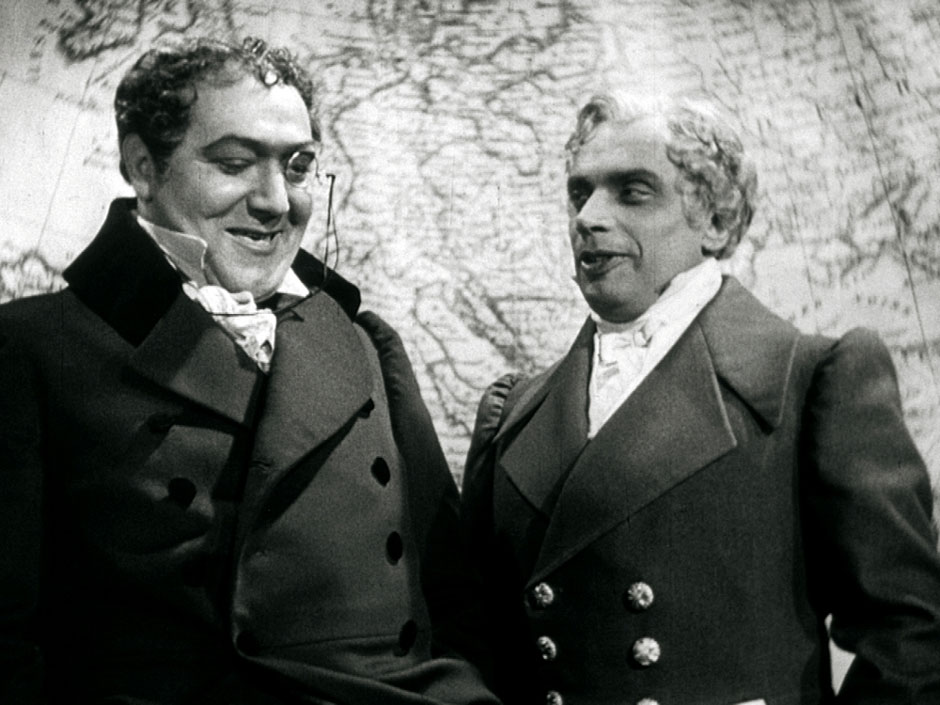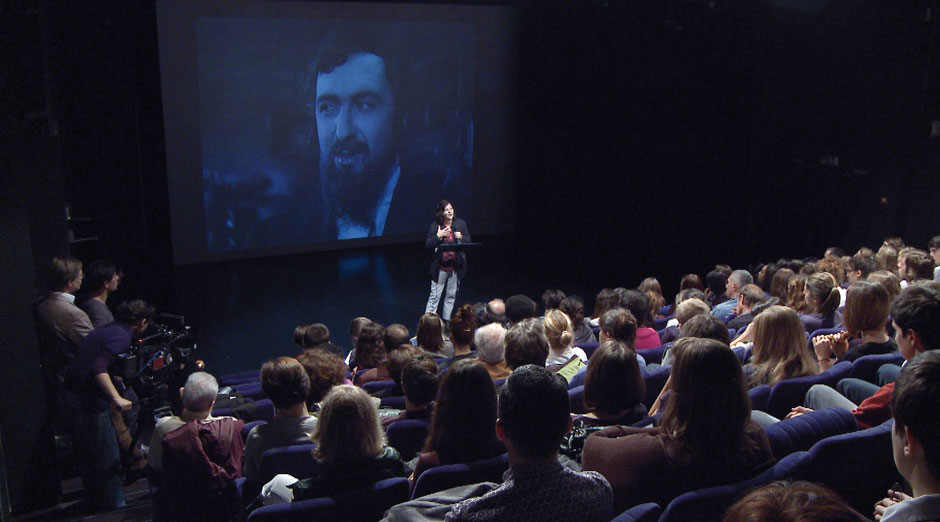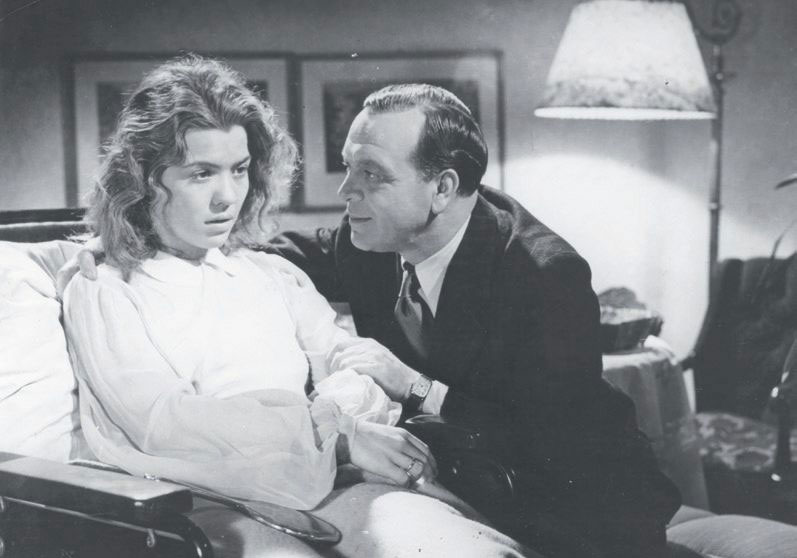Forbidden Films, Felix Moeller’s excellent documentary about “the hidden legacy of Nazi film,” begins with a sequence that functions as an apt metaphor for everything that will follow. In the opening shots, we see the German Federal Film Archive, a heavily reinforced, bunker-like structure in the suburbs of Berlin, bordered by a grassy hummock engineered to cushion the force of an explosion. The reason for these security measures, we learn, is that among the archive’s holdings are some 70,000 reels of highly flammable cellulose nitrate; were a fire to break out, the film stock would detonate with the force of a large and destructive bomb. Many of these canisters contain propaganda films produced under the aegis of the National Socialist Party, including some forty movies made between 1933 and 1945—that are still illegal to show publicly in Germany, except in an approved academic setting. What Forbidden Films seeks to answer is the question of whether these films are not only chemically but politically incendiary—and whether they should continue to be banned.
In the film, Moeller travels through Germany, Israel and France, interviewing historians, audience members who have just seen the controversial movies, and two German former neo-Nazis. He visits a university classroom in Paris, attends a public discussion following a screening in Jerusalem, and a panel during which representatives from German film institutes discuss the rationale for, and the efficacy of, their country’s censorship laws. Interspersed with these scenes is footage, some quite extensive, from a range of Nazi cinema.
Viewers familiar with Moeller’s earlier documentary, Harlan: In the Shadow of Jew Süss (2008)— which focused on Veit Harlan, the director of the Nazis’ most popular and notorious anti-Semitic feature film—will already have experienced the awfulness of Jew Süss (1940), an elaborate costume drama about an eighteenth-century financier with nefarious plans that include a Jewish take-over of Germany; in one appalling scene, Süss rapes a beautiful Christian woman who has resisted his advances, baiting her all the while to pray to her God to save her. Forbidden Films also includes a sequence from another anti-Semitic “classic,” Die Rothschilds, in which a schematic diagram of the places (London, Naples, Jerusalem, etc.) that the banking family plans to dominate takes the form of a six-pointed Jewish star.
In addition to the films designed to dehumanize Jews and justify the Final Solution, Joseph Goebbels’s propaganda machine also produced a wide variety of lesser-known works that demonized the British and French, glorified war, and attempted to rewrite history in accordance with the National Socialist agenda. A long section of Moeller’s documentary deals with a film entitled Homecoming (1941), which characterized the invasion of Poland as a humanitarian rescue mission launched to save ethnic Germans from brutal mistreatment by the Poles. A horrifying sequence shows a young German woman being stoned to death by Polish children whose murderous efforts are redoubled when a man tears a delicate swastika pendant from around the victim’s neck. In another scene, German prisoners are comforted by a woman’s oration about the joys of going home, where they will no longer be forced to hear Yiddish and Polish spoken in the shops, and where they will be surrounded only by other Germans.
The questions that animate Forbidden Films—Should these films be publicly shown? Who should be allowed to see them and under what circumstances?—are raised and returned to, considered and reconsidered. How can a society weigh its belief in free expression against its anxiety about the possible consequences of that freedom? The matter of free speech vs. hate speech is always a thorny and vexed one; here the complications surrounding these issues are magnified by the horrors of twentieth-century German history, by the ways in which contemporary Germans view that history, and finally by the fact that these officially “banned” films are in fact available; they can be watched (in a somewhat degraded form) on YouTube and ordered from Neo-Nazi web sites. The two former neo-Nazis, who appear in silhouette, describe watching The Eternal Jew—arguably the most odious and extreme of the anti-Semitic Nazi films—at gatherings of right-wingers who are drinking beer, laughing, and reciting the text (which they know by heart) along with the voice-over narration. One of them says that “a normal thirteen or fourteen year-old” won’t ask to see Jew Süss, but “people who are already exposed to the scene” want to see the films, which they’ve heard about. “It’s a way to come into contact with people, and bring friends…And these people can be indoctrinated.”
In the course of Forbidden Films, we hear what would seem to be the entire spectrum of views on these issues. An Auschwitz survivor in Paris suggests that the films should remain banned, because “to show them to an unprepared audience during a crisis when people are looking for scapegoats…. I think that’s dangerous. We are living in a time of crisis. It’s better to be too careful than not enough.” Moshe Zimmermann, a historian at the Hebrew University of Jerusalem cautions, “The danger exists that certain stereotypes are expressed and become further established.” But a man in a Jerusalem audience says that every Israeli schoolchild should be required to watch these films: “Every child should be familiar with and understand what is being shown so they can dispute and reject it.” A German film director laments the fact that these films are widely unavailable, because the ban deprives Germans in general (and German film enthusiasts in particular) of an essential part of their history.
Advertisement
Nearly everyone who speaks in the film agrees that context is all-important; that the films need to be exhibited as examples of vile propaganda, that the lies they promulgate need to be exposed, and that an audience should be told about the damage that these works helped to inflict. This seems especially critical not just in regard to the overt and insidious stereotypes of the “racial” films. Despite its old-fashioned sentimentality, its excessive nationalism and gratuitous violence, one could imagine that Homecoming might be quite persuasive when seen by a young person who knows nothing of twentieth-century history and is consequently vulnerable to the film’s portrayal of the Germans as heroic liberators, freeing their countrymen from the persecutions of the barbaric Poles, who are shown intimidating and brutalizing their German subjects, doing exactly what in fact the Germans did to the Poles. On film the Poles appear to be so cruel, and the Germans so innocent—something had to be done.
One of the most fascinating and disturbing sequences in Forbidden Films deals with Ich Klage An (1941), I Accuse, a film that was used to foster public discussions of euthanasia and to persuade the German public of the necessity of the Nazi euthanasia program. In the film, a doctor’s young and beautiful wife, afflicted with multiple sclerosis, begs her husband to “release” her before her sufferings increase and she degenerates into an unrecognizable version of herself—“blind and deaf, an idiotic cripple.” Her husband accedes to her wishes and is tried for murder in court, a trial that involves a plea to legalize the right to die. “Her suffering was inhumane,” the doctor claims in his own defense. “That is why I released her.” During the period that the film was being produced and shown, the Nazis had already murdered, or would subsequently murder, a total of some 70,000 people who were mentally and physically disabled and ill—involuntary deaths that were wholly unlike the longed-for “release” that the films portrays.
Present at the panel that accompanies a screening of I Accuse is Johanna Lebeneiner, who is the daughter of the film’s director, Wolfgang Liebeneiner, and who displays many of the same conflicted loyalties, guilt and bewilderment that one could observe in the descendants of Veit Harlan in Moeller’s earlier documentary. We watch the expression on her face change as one audience member praises her father’s film, while another decries it as “slick and malicious.” But ultimately what makes this sequence extraordinary is the commentary of the German political scientist and historian Götz Aly, whose thoughtful reflections seem more incisive than many of the opinions we’ve heard so far in the film—responses which, however heartfelt, are not entirely unfamiliar. The film, Aly says, was meant to soothe the “Christian conscience” of the German people, whose attitudes toward the mass killings were “somewhere between not needing to know and not wanting to know. For that you need a bit of drama.” I Accuse, he goes on to say, represents the “soft, nice, pleasant side of National Socialism,” which was “very much like the hard, marching, uniformed side, the drum-roll side….This side was every bit as important in making their mass crimes possible.”
It’s Aly who is given the last word in Forbidden Films. The ban on the films, he says, is “as ridiculous as the ban on Mein Kampf…. I think we should make it all freely available and we’ll just have to talk about it. Of course there’ll be abuse. But I think it’s better than when it’s all covered up.” It’s as apt a conclusion as the shots of the fortified film bunker are a beginning. Moeller’s documentary has taken an important step toward opening a discussion that can only be more useful than silence, or than the warehousing of these films in a structure where they remain unseen, prohibited—and liable to explode.
Advertisement
Felix Moeller’s Forbidden Films will be shown in the United States at select
museums and festivals this summer.







